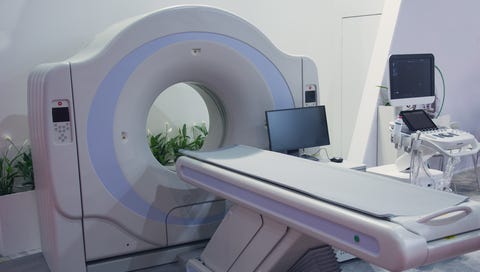In 2017, an article was published by James Anderson and Kathleen Abrahamson entitled, “Your Health Care May Kill You: Medical Errors.” The article once again exposed that medical errors may account for as many as 251,000 deaths annually in the United States (U.S). The incredibly high number was first reported in the British Medical Journal in 2016. This makes medical errors the third leading cause of death in America. Surprisingly, the rates in the US are higher than rates in other developed countries such as Canada, Australia, New Zealand, Germany, and the United Kingdom (U.K). At the same time, apparently less than 10 percent of medical errors are reported.
An overlooked, potentially serious complicating factor of a hospital stay is the number of x-ray exams ordered that use contrast agents. Contrast materials, also called contrast media (CM), are substances used to enhance the distinction between normal and abnormal tissues, greatly improving the radiologist’s ability to differentiate between normal and abnormal tissue densities. Ideally, CM should achieve a very high concentration in the tissues without producing any adverse effects. Unfortunately, this has not been possible so far, and all CMs have adverse effects. Radiologists must be wary of reactions in patients with a previous history of life-threatening reactions, bronchospasm or asthma, hypotension, or shock from an underlying illness and be aware that premedication does not completely eliminate the risks of severe and life-threatening reactions in those patients.
These substances are administered either orally, rectally, or intravenously. The type of contrast used depends on the modality and purpose of the imaging the patient will receive. Material administered for MRI or computerized tomography (CT) scans is NOT radioactive.
Barium
An older, but long-used test of CM is a barium enema, used to determine the cause of signs and symptoms, such as the following:
Abdominal pain
Rectal bleeding
Changes in bowel habits or stool size (diameter)
Unexplained weight loss
Chronic diarrhea
Persistent constipation
This test has mostly been replaced by newer imaging tests that are more accurate, such as a colonoscopy or a CT scan. However, barium enemas are still used if the patient’s colonoscopy is incomplete or the CT scan is inconclusive.
Barium sulfate is used worldwide for routine studies of the upper and lower gastrointestinal tract. Barium doesn’t dissolve in water and therefore is not absorbed systemically. However, constipation and abdominal pain are common complications after a barium drink or a barium enema. The barium can remain in the colon for 6 weeks or longer, especially in elderly patients. Barium stones (called fecaliths) may even have to be removed surgically. Residual residues have caused appendicitis.
The most serious complication of a barium enema is a perforated colon, usually due to a weakness in the colon’s wall due to disease or inflammation, although it can be caused by poor placement or rough insertion by the practitioner. Even though the incidence is thought to be very small (between 0.02–0.23%), if barium is spilled into the abdominal area, sepsis and peritonitis rapidly follow, leading to a mortality rate of 50% or greater. Case #1 Case #2
Iodinated Contrast Materials
Iodine-containing contrast media (ICCM) is used frequently in diagnostic studies. It is usually administered through IV tubing and redistributes quickly throughout the body. It is important to note that ICCM is a nonradioactive substance.
Types of tests that nearly always use ICCM include:
angiograms/angiography (X-rays of blood vessels - example: heart catheterization)
arthrography (X-ray of the inside of a joint, such as the shoulder)
myelography (injection of contrast medium into the fluid around the spinal cord)
almost all CT scans (may be given orally or via IV)
The most common toxicity associated with an iodine-containing contrast agent is contrast-induced nephropathy (CIN). CIN is a kidney injury identified as a sudden decrease in kidney function within 24 to 48 hours of a dose of contrast agent. CIN can result in a long hospital stay, greatly increased cost of treatments, and an increase in both disability and mortality. Because contrast agents are used so frequently, CIN has long been a significant issue. In the general population, the incidence of CIN is 2%, but it can be as high as 20-30% in high-risk populations such as patients with chronic kidney disease, diabetes mellitus, congestive heart failure, and the elderly.
In the past, the use of high osmolar (concentrated) agents resulted in an adverse reaction in up to 15% of patients. Fortunately, the use of newer low osmolar agents has significantly decreased the adverse reactions to a range of 0.2% to 0.7%
A new study, published in April 2023, demonstrated a scoring system for predicting CIN in patients with chronic kidney disease. Investigators determined that male gender, diabetes mellitus, a heart ejection fraction less than 45%, and a kidney filtration rate (eGFR) of less than 50 were independent risk factors. When the new scoring system was applied, patients with a new scoring system score of ≥4 were at approximately 40 times higher risk of developing CIN than others.
Since this study is relatively new, I suggest you print it and have it with you if you or a loved one is going to have any tests using IV contrast with iodine and ask your physician to review it.
Another complication just coming to light regarding the pervasive use of iodinated contrast media: the pathologic effects of ICCM on cardiovascular complications in patients who were also undergoing dialysis. A 10-year follow-up study found a major risk of cardiovascular disease after exposure to ICCM. The group who had CTs with ICCM had the following outcomes increased:
all-cause mortality
cardiovascular events
acute coronary syndrome
sudden cardiac arrests
heart failure
strokes.
Because ICCM is significantly pro-inflammatory, it is associated with an increased risk of major cardiovascular events in patients on dialysis. The assumption can be made that even those with normal kidney disease are also at increased risk when subjected to repeated procedures and scans that include iodine-containing contrast media (ICCM).
In a separate study, published in 2015, a retrospective chart review of more than 33,000 patients identified ICCM exposure during CT as a risk factor for the subsequent development of thyroid disorders in patients without known thyroid disease, within six months of a single CT scan with contrast. The risk increased with repeated exposure.
ICCM and Pregnancy
Contrast media crosses the human placenta and enters the fetus. ICCM can also be secreted into milk during lactation. The amount of free iodine in the contrast medium in the injection is normally under 1% but can increase if it has been in storage. Free iodine can reach the fetal thyroid, possibly leading to fetal hypothyroidism. As a general rule, giving any drug to a pregnant woman, including injecting ICCM, needs to be carefully considered. It is suggested that iodine-containing contrast media should be limited to urgent diagnostic indications after the twelfth week of gestation.
Iodine “Allergy”
A long-standing rule has been that if a person has had a reaction to shrimp, seafood, or other types of shellfish, they are allergic to iodine and should avoid intravenous iodinated contrast materials. In 2010, a study published in the Journal of Emergency Medicine debunked this association by concluding:
Iodine is not an allergen. Atopy, (an increased propensity to hypersensitivity reactions), confers an increased risk of reaction to contrast administration, but the risk of contrast administration is low, even in patients with a history of "iodine allergy," seafood allergy, or prior contrast reaction. Allergies to shellfish, in particular, do not increase the risk of reaction to intravenous contrast any more than other allergies.
A literature review also showed the conflation of shellfish allergies with iodine allergies to be a medical myth, noting that there was no increase in allergic-like reactions to ICCM in patients with known seafood allergies.
I have long said this: if a person reacts to the ICCM, it’s something else in the solution, not the iodine. I am glad to finally see this in a published study.
Gadolinium
Gadolinium (Gd) is a known heavy metal, and it is considered highly toxic in biological systems. To be used as a contrast agent, gadolinium must be bound to carrier molecules called chelating agents. The chelating agent prevents the toxicity of gadolinium while maintaining its contrast properties to improve visualization of internal organs, blood vessels, tumors, and tissues. In 1993, the FDA approved the first GBCA), gadodiamide (Omniscan®). In an effort to minimize risks of nephrotoxicity from ICCMs, the use of GBCAs became commonplace in the 1990s and early 2000s in patients with any degree of renal impairment.
GBCAs have been used in America since 1988 and are now utilized in almost 33% of all MRIs. Approximately 4.5 million Americans are exposed to GBCAs each year. The United States has the second-highest MRI utilization rate as opposed to any other country after Germany. Think of how many repeat “MRIs with contrast” may be ordered in trauma or cancer patients?
Off-label use of contrast media is extremely common, mostly involving GBCAs, especially in angiography, cardiac, and pediatric applications. The ideal contrast medium should achieve high concentrations in the tissues without producing any adverse effects. Unfortunately, this has not been possible so far, and as stated previously, all CMs have adverse effects.
The following information about this horrible condition was extracted from this long and detailed paper:
In 2000, physicians at the University of California, San Francisco, published a case series of 14 patients with a previously unknown fibrosing disorder. The authors characterized this condition as a “scleroderma-like cutaneous disease” because of the severe skin fibrosis (thickening) observed. All 14 patients also had dialysis-dependent kidney disease. The authors termed this new condition nephrogenic fibrosing dermopathy (NFD). Within just a few years, scores of NFD case reports were published from around the globe. It was found that NFD included widespread systemic fibrosis of multiple organ systems, not just localized to the skin. Accordingly, the term was changed to nephrogenic systemic fibrosis (NSF).
NSF has been reported in patients as young as 8 years of age. Cases of NSF were described in patients who had previously experienced severe acute kidney injury but had recovered normal renal function. Only later would it be realized that these patients had been exposed to a GBCA during their period of severe renal impairment. In all patients with renal disease, GBCAs persist for many more hours after administration than in individuals with normal renal function. Unfortunately, many cases of NSF occurred after only a single dose of a high-risk GBCA. The time to disease onset may be days to years after the last GBCA exposure.
The term gadolinium-induced fibrosis most accurately reflects the totality of the understanding of this condition. There were more than 1,000 lawsuits filed between 2008 and 2015 against the manufacturers of GBCAs. Within minutes to up to two months after having an MRI or MRA where a linear GBCA is utilized, patients with normal kidney and renal function can develop symptoms consistent with gadolinium toxicity. The manufacturers of the GBCAs had failed to warn healthcare providers of this danger.
Between 2000 and 2019, the FDA reported 3,094 cases of NSF, including 742 deaths and 2,962 serious cases. The exact pathogenesis is unknown, but most studies hypothesized that gadolinium might dissociate from its chelate and become free Gd. In patients with advanced kidney disease, the injected GBCA remains in the body for more hours than those with normal renal function. Clinical manifestations of NSF may occur days or even years after exposure to GBCA but usually present within 2-10 weeks.
To recap:
Nephrogenic Systemic Fibrosis (NSF) is a slowly developing but chronically debilitating and progressive disease that causes the skin to harden, and joints to contract, particularly the ankles and the wrists. The thighs and upper arms are most commonly affected. Chronic pain and loss of mobility are common.
Gadolinium Deposition Disease (GDD) causes patients to suffer fibrosis (thickening and scarring of connective tissue) in an organ, bone, and skin, and gadolinium is retained in the brain. Symptoms start within minutes up to two months after an MRI or MRA where a linear gadolinium-based contrast agent was utilized.
Different brands of gadolinium contrast medium use different chelating molecules; as of 2018, there were 8 FDA-approved gadolinium-based contrast agents. Some of them are known to retain more gadolinium in the body than others. In May 2018, as part of the class-action settlement, the FDA required all the manufacturers to place detailed warnings on their labels, acknowledging that, indeed, GBCAs ARE retained in the body.
To date, there are no proven treatments that cure NSF. Because the condition occurs in conjunction with severe renal disease regular chelation, such as with EDTA, is out of the question. A gentle, heavy metal detox using Pure Body Extra may be helpful. If you’re scheduled for an MRI for any reason, I would suggest using 3-4 sprays 3 times a day a few days before, right after, and a few days after an MRI with contrast. While not proven, it just might help.
These issues should give rise to the knee-jerk way that MRIs and CTs with contrast are often ordered. In short, contrast toxicity can be caused by any contrast agent in any patient.
Be sure you discuss these concerns with your physician and be sure you have kidney function labs (BUN, creatinine, eGFR) ordered before giving informed consent to these, or any other medical procedure, especially when adverse reactions could be deadly.









In other words...allopathic medicine will kill you...stay away from the medical cartel, they’re only in it for the money and don’t give two shits about healing you. Drugs are their only method of “treatment” because they’re bought, taught and owned by the pharmafia and their controlled medical “schools”.
And they only “treat” symptoms and NEVER the root cause of any illness.
Seek and ye shall find......cancer. I stopped seeking for it and four decades later... no cancer diagnosis. Avoid the white coats. Why does anyone think a stranger in a lab coat cares about you? You are not their grandchild.